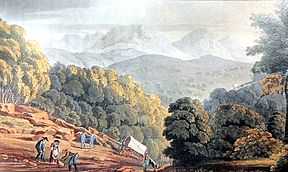Christian Ignatius Latrobe
| Christian Ignatius Latrobe | |
|---|---|
 | |
| Personal details | |
| Born |
12 February 1758 Fulneck Moravian Settlement, West Riding of Yorkshire, England, Kingdom of Great Britain |
| Died |
6 May 1836 (aged 78) Fairfield, Lancashire, England, United Kingdom of Great Britain and Ireland |
| Denomination | Moravian |
Christian Ignatius Latrobe was an English clergyman of the Moravian Church, as well as an artist, musician and composer. He created a large number of works for, and most famously edited, a Selection of Sacred Music in six volumes between 1806 and 1826, introducing the sacred music of Haydn, Mozart and Pergolesi to English audiences.
Life
He was born in the Fulneck Moravian Settlement, near Leeds, to the Reverend Benjamin Latrobe, of Huguenot descent, and the American-born Anna Margaretta Antes. His brother was Benjamin Henry Latrobe, the noted architect responsible for the United States Capitol and the Catholic cathedral of Baltimore, Maryland.
In 1771 Christian Latrobe went to Niesky in the Upper Lusatia region of Saxony in Germany, to attend the Moravian College there. On completion of his training he taught at the high school attached to the college for a while, after which he returned to England and was ordained in 1784.
As a promoter of the missionary activity of the Church, in 1815 Latrobe voyaged to the Cape of Good Hope to visit the Moravian mission stations there. Once there, he journeyed from Genadendal to George, Uitenhage, and the Great Fish River. He planned the founding of a new mission station called Enon on the Witrivier near Kirkwood. He described his journey with coloured illustrations in Journal of a Visit to South Africa in 1815 and 1816: With Some Account of the Missionary Settlements of the United Brethren, Near the Cape of Good Hope. He also wrote History of the Mission of the United Brethren Among the Indians in North America in 1794.
Latrobe often brought newly published music from the Continent to England in the early 19th century. He purchased a number of music scores and oratorios from Breitkopf & Härtel in Leipzig, near Niesky, when they were not published due to a perceived lack of interest. These pieces might well have included a Mozart arrangement of Handel's Judas Maccabaeus (1747) discovered in 2001 in Halifax, West Yorkshire.
Latrobe recalled that not long after Haydn arrived in England in 1790, he called at Latrobe's home. After confirming that he was at the correct place, Haydn asked Mrs. Latrobe "be you his woman?" and spotting a picture of himself said "dat is me – I am Haydn". Mrs. Latrobe hurriedly sent for her husband who was at a house nearby. A fairly close friendship grew out of this meeting and Latrobe became a regular visitor at Haydn's home during his two stays in England.
Three of Latrobe's piano sonatas were dedicated to Joseph Haydn. He also wrote clarinet concertos, duets and arias, and more than a hundred vocal pieces, among which were "Lord of Life Now Sweetly Slumber", "How Shall a Mortal Song Aspire", "Psalm 51" and "We Praise Thee, Oh God".
He died in the Fairfield Moravian Settlement on 6 May 1836, at the age of 78, and was buried there.[1]
Family
Christian Latrobe married Hannah Benigna Syms (28 October 1758 – 18 April 1824). Their children were:
- Charlotte Louisa Latrobe (1794–1879)
- Peter Latrobe (15 February 1795 – 24 September 1863), Bishop of the Moravian Church, married firstly Mary Louisa Foster on 27 December 1825, had issue, and secondly Jeanetta Margaret Brett
- Anna Agnes Latrobe (1796–1832)
- John Antes Latrobe (1799–1878), writer on music, unmarried
- Charles Joseph Latrobe (20 March 1801 – 4 December 1875), Lieutenant-Governor of Victoria, married firstly Sophie de Montmollin (died 30 January 1854) on 16 September 1835 in Bern, Switzerland, had issue, and secondly Rose Isabelle de Montmollin, had issue
- Frederick Benjamin Latrobe (1803 – 11 December 1842), married Elizabeth Scott, had issue
Illustrations by Latrobe from Journal of a Visit to South Africa



Notes
References
- Latrobe genealogy
- The Musical Times (1851)
- Mason, John C. S. (2004). "La Trobe, Christian Ignatius (1758–1836)". Oxford Dictionary of National Biography. Oxford University Press. doi:10.1093/ref:odnb/16107. Retrieved 22 November 2009. (subscription or UK public library membership required)
External links
![]() Media related to Christian Ignatius Latrobe at Wikimedia Commons
Media related to Christian Ignatius Latrobe at Wikimedia Commons
- Works by Christian Ignatius Latrobe at Project Gutenberg
- Works by or about Christian Ignatius Latrobe at Internet Archive
- Family tree in Genealogisches Handbuch der baltischen Ritterschaften, Estland, Görlitz 1930 (German)
-
 "Latrobe, Christian Ignatius". Dictionary of National Biography. London: Smith, Elder & Co. 1885–1900.
"Latrobe, Christian Ignatius". Dictionary of National Biography. London: Smith, Elder & Co. 1885–1900.
| ||||||||||||||||||||||||||||||||||||||
|